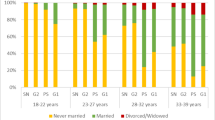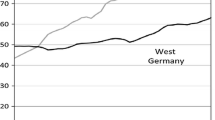Abstract
Views differ on how migration affects the timing of childbearing. Whereas migration has long been considered a break in the life course, hindering family formation, this disruption hypothesis has recently been challenged. New findings indicating that there is often an acceleration of childbearing shortly after migration have led to the formulation of the interrelation hypothesis. Examining the childbearing behaviour of Polish women, this study extends previous research by combining information from the countries of origin and of destination. Using retrospective data from Poland (derived from the European Social Survey) and Britain (derived from the Labour Force Survey), discrete-time event history methods are applied to study the transition to a first birth in relation to the timing of migration. The results show that there is a disruption of childbearing prior to migration, as well as an acceleration of fertility in the years immediately following the move.




Similar content being viewed by others
References
Abbasi-Shavazi, M. J., & McDonald, P. (2002). A comparison of fertility patterns of European immigrants in Australia with those in the countries of origin. Genus, 58(1), 53–76.
Allison, P. (1982). Discrete-time methods for the analysis of event histories. Sociological Methodology, 13, 61–98.
Andersson, G. (2004). Childbearing after migration: Fertility patterns of foreign-born women in Sweden. International Migration Review, 38(2), 747–774.
Andersson, G., & Scott, K. (2005). Labour-market status and first-time parenthood: The experience of immigrant women in Sweden, 1981–97. Population Studies, 59(1), 21–38.
Blossfeld, H.-P., Golsch, K., & Rohwer, G. (2007). Event history analysis with Stata. Mahwah, New Jersey: Lawrence Erlbaum.
Boyle, P., Kulu, H., Cooke, T., Gayle, V., & Mulder, C. (2008). Moving and union dissolution. Demography, 45(1), 209–222.
Burrell, K. (2009). Polish migration to the UK in the ‘new’ European Union: After 2004. Farnham, Surrey: Ashgate.
Carlson, E. D. (1985). The impact of international migration upon the timing of marriage and childbearing. Demography, 22(1), 61–72.
Clark, K., & Drinkwater, S. (2008). The labour-market performance of recent migrants. Oxford Review of Economic Policy, 24(3), 495–516.
Coleman, D. A., & Dubuc, S. (2010). The fertility of ethnic minorities in the UK, 1960s–2006. Population Studies, 64(1), 19–41.
Cook, J., Dwyer, P., & Waite, L. (2011). The experiences of accession 8 migrants in England: Motivations, work and agency. International Migration, 49, 54–79.
Dubuc, S. (2009). Application of the own-child method for estimating fertility of women by ethnic groups in the UK. Journal of Population Research, 26, 2007–2225.
European Social Survey (2011). ESS-5 2010 Documentation Report.
Eurostat. (2010). Criteria for the anonymisation of LFS microdata. Retrieved from http://circa.europa.eu/irc/dsis/employment/info/data/eu_lfs/LFS_MAIN/Anonymisation/Criteria%20for%20the%20anonymisation.pdf. Accessed July 2013.
Eurostat. (2014). Demographic statistics. Luxembourg: Eurostat.
Ford, K. (1990). Duration of residence in the United States and the fertility of U.S. immigrants. International Migration Review, 24(1), 34.
Goldstein, S., & Goldstein, A. (1981). The impact of migration on fertility: An ‘own children’ analysis for Thailand. Population Studies, 35(2), 265–284.
Home Office. (2007). Accession monitoring report A8 countries: May 2004–June 2007. Retrieved from http://webarchive.nationalarchives.gov.uk/20100422120657/http://www.ukba.homeoffice.gov.uk/sitecontent/documents/aboutus/reports/accession_monitoring_report/. Accessed July 2013.
Home Office. (2009). Accession monitoring report A8 countries: May 2004–March 2009. Retrieved from http://webarchive.nationalarchives.gov.uk/20100422120657/http://www.ukba.homeoffice.gov.uk/sitecontent/documents/aboutus/reports/accession_monitoring_report/. Accessed July 2013.
Huinink, J., & Feldhaus, M. (2009). Family research from the life course perspective. International Sociology, 24(3), 299–324.
Kahn, J. R. (1994). Immigrant and native fertility during the 1980s: Adaptation and expectations for the future. International Migration Review, 28(3), 501–519.
Kley, S. (2011). Explaining the stages of migration within a life-course framework. European Sociological Review, 27(4), 469–486.
Kotowska, I., Józwiak, J., Matysiak, A., & Baranowska, A. (2008). Poland: Fertility decline as a response to profound societal and labour market changes? Demographic Research, 19, 795–854.
Kulu, H. (2005). Migration and fertility: Competing hypotheses re-examined. European Journal of Population, 21(1), 51–87.
Landale, N., & Ogena, N. (1995). Migration and union dissolution among Puerto Rican women. International Migration Review, 45(1), 671–692.
Lindstrom, D. P., & Saucedo, S. G. (2002). The short- and long-term effects of U.S. migration experience on Mexican women’s fertility. Social Forces, 80(4), 1341–1368.
Matysiak, A. (2009). Employment first, then childbearing: Women’s strategy in post-socialist Poland. Population Studies, 63(3), 253–276.
Milewski, N. (2007). First child of immigrant workers and their descendants in West Germany: Interrelation of events, disruption, or adaption? Demographic Research, 17, 859–896.
Milewski, N. (2010). Immigrant fertility in West Germany: Is there a socialization effect in the transition to second and third births? European Journal of Population, 26, 297–323.
Mulder, C. H., & Wagner, M. (1993). Migration and marriage in the life course: a method for studying synchronized events. European Journal of Population, 9, 55–76.
Ng, E., & Nault, F. (1997). Fertility among recent immigrant women to Canada, 1991: An examination of the disruption hypothesis. International Migration, 35(4), 559–580.
Office for National Statistics. (2010). Parents’ country of birth 2009. Retrieved from http://www.statistics.gov.uk/downloads/theme_population/country-of-birth-tables.xls. Accessed July 2013.
Office for National Statistics. (2011). Labour force survey—User guidance: Volume 1: Background and methodology. Retrieved from http://www.ons.gov.uk/ons/guide-method/user-guidance/labour-market-statistics/index.html. Accessed July 2013.
Pollard, N., Latorre, M., & Sriskandarajah (2008). Floodgates or turnstiles? Post-EU enlargement migration flows to (and from) the UK. London: Institute for Public Policy Research.
Retherford, R. D., & Cho, L.-J. (1978). Age-parity-specific birth rates and birth probabilities from census or survey data on own children. Population Studies, 32(3), 567–581.
Ryan, L., Sales, R., Tilki, M., & Siara, B. (2009). Family strategies and transnational migration: Recent Polish migrants in London. Journal of Ethnic and Migration Studies, 35(1), 61–77.
Singley, S. G., & Landale, N. S. (1998). Incorporating origin and process in migration-fertility frameworks: The Case of Puerto Rican women. Social Forces, 76(4), 1437–1464.
Stephen, E. H., & Bean, F. D. (1992). Assimilation, disruption and the fertility of Mexican-origin women in the United States. International Migration Review, 26(1), 67–88.
Trevena, P. (2009). ‘New’ Polish migration to the UK: A synthesis of existing evidence. Centre for Population Change Working Paper, 3.
Waller, L., Berrington, A., & Ryamer, J. (2014). New insights into the fertility patterns of recent Polish migrants in the United Kingdom. Journal of Population Research (In Press).
White, A. (2011). Polish families and migration since EU accession. Bristol: Policy Press.
White, M. J., Moreno, L., & Guo, S. (1995). The interrelation of fertility and geographic mobility in Peru: A hazards model analysis. International Migration Review, 29(2), 492–514.
Wolf, K. (2014). Fertility of Turkish migrants in Germany: Duration of stay matters. MPIDR Working Paper WP 2014-001.
Yamaguchi, K. (1991). Event history analysis. Newbury Park: Sage Publications.
Acknowledgments
I would like to thank Marcel Erlinghagen, Karsten Hank, Thorsten Schneider, the anonymous reviewers, and the editors of the European Journal of Population for their valuable comments on an earlier version of this paper.
Author information
Authors and Affiliations
Corresponding author
Rights and permissions
About this article
Cite this article
Lübke, C. How Migration Affects the Timing of Childbearing: The Transition to a First Birth Among Polish Women in Britain. Eur J Population 31, 1–20 (2015). https://doi.org/10.1007/s10680-014-9326-9
Received:
Accepted:
Published:
Issue Date:
DOI: https://doi.org/10.1007/s10680-014-9326-9




